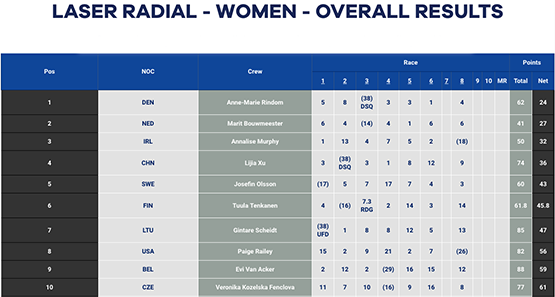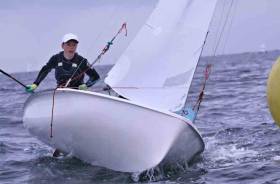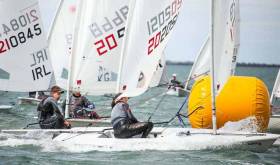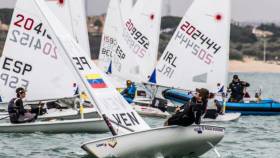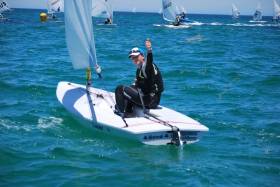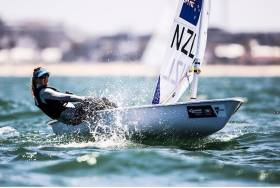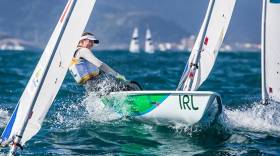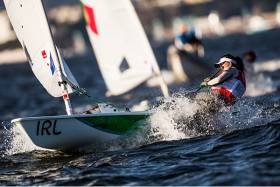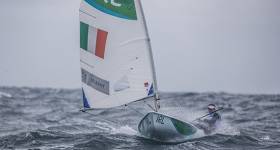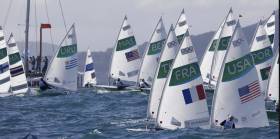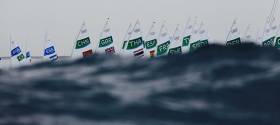Displaying items by tag: Radial
Over 130 boats took to the water today at Ballyholme Yacht Club on Belfast Lough on Day 1 of the ISA Youth Pathway National Championships and Optimist Trials. The event is supported by Ards & North Down Borough Council. Only 2 courses were sailed today with the Topper and Laser 4.7 fleets starting tomorrow instead.
On the Optimist course, 3 races were completed in a light steady westerly breeze- the first two races saw all of the competitors behaving themselves on the start line but the eager youngsters couldn't help themselves on the final start with a single general recall under Race Officer Harry Gallagher.
The sailors from Royal Cork Yacht Club showed the strongest form with 13 year old Justin Lucas winning the first two races and Cillian Forster the last. First Junior overall after Day 1 is Luke Turvey from Howth YC in 7th whilst first lady is Emily Riordan from Royal St George in Dun Laoghaire. Four races are scheduled for thw Optimists tomorrow.
On Course 1, Gemma McDowell and Emma Gallagher lead overall in the double-handed 420 class with 1,2,2 from Kate Lyttle and Niamh Henry (3,4,1)
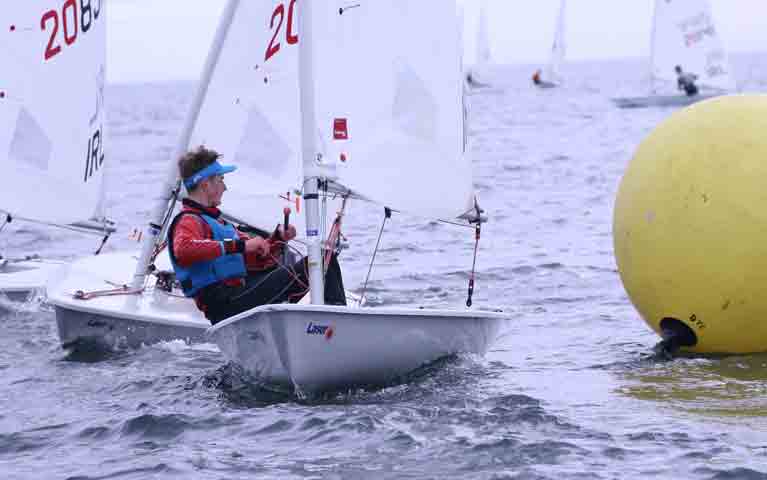 Laser Radials reach the weather mark in the first race of the ISA Youth Championships. Photo: Simon McIlwaine
Laser Radials reach the weather mark in the first race of the ISA Youth Championships. Photo: Simon McIlwaine
The Laser Radial fleet is the glamour fleet this weekend with ISA Performance squad members Howth's Ewan McMahon and Cork's Johnny Durcan battling it out with future ISAF Youth Worlds selection in view later this year - however Aaron Rogers from Rush leads overall with 1,2,1. Royal North's Sally Bell leads the ladies.
Racing continues until Sunday with 4 races scheduled for the Optimists and 3 for the other classes starting at 11:00 tomorrow. Tomorrow night Olympic Silver Medallist Annalise Murphy will be present to give a welcome and a talk to all the youth sailors on how to campaign for future international success.
Annalise Murphy To Share Expertise At ISA Youth Sailing Championships in Northern Ireland
Annalise Murphy is just one of four evening talks taking place at the ISA Youth Sailing National Championships, being held at Ballyholme Yacht Club, 19-23 April. As Afloat.ie reported previouslty, it is the first time the event has been sailed in Northern Ireland.
The evening talks as well as the races are open to all young sailors who sail in the five ISA Youth Pathway Classes (Laser Radial, Laser 4.7, 420, Topper, Optimist). This is Ireland’ largest Youth regatta and the ISA’s primary talent spotting event of the year for the Academy and Junior classes. The ISA squad programmes will resume this summer in the Laser 4.7 and Topper classes, and these classes will have a squad trial to identify future ISA Pathway sailors. In addition, ISA spotters are out to assess sailors for Academy trials for the Laser Radials and 420s. (The Optimists will have separate Class-organised talent spotters).
Eight places on the ISA Topper Squad
In the Topper class up to eight sailors will be selected to join the ISA Topper Squad. The Squad coach and programme will be announced following the event. The programme aimed at developing young Topper sailors will provide training and also support at the 2017 Topper World Championship to be held in Brittany, France in July. Entry to the World championship is independent of ISA squad selection and through the International Topper Class Association.
Five places on the ISA Laser 4.7 Squad
Up to five sailors will be chosen at the ISA Youth Pathway Nationals to join the ISA 4.7 Squad. A further two sailors may be chosen at the 2017 Laser 4.7 Ulster Championship. The ISA 4.7 squad will provide training to help young sailors transition in the Laser 4.7 class. It will also aim to prepare and support the squad for the Laser 4.7 World Championship to be held in Nieuwpoort, Belgium in July. The squad coach and programme will be announced following event. Entry to the 4.7 Worlds is independent of ISA squad selection through the International Laser Class Association.
A line–up of big name evening speakers – including Annalise Murphy – open to all:
At 5.30pm each evening there will be a talk and Q&A session at the Ballyholme Yacht Club with speakers who have a deep knowledge of racing. The talks are open to all sailors and parents.
Full list of Evening Speakers:
Wednesday 19th April, BILL O'HARA will discuss “What to consider when preparing for an event - Rules Strategy for racing”. Bill is the current Principal Race Officer for the Volvo Ocean Race, International Umpire and Rules adviser to the Irish Olympic Team.
Thursday 20th April, Annalise Murphy (Olympic Silver medalist) will share her insights in a talk entitled “Beat the Best: Preparing for Competitive Gains at the Olympics”.
Friday 21st April, Matt McGovern (Double Olympian 49er Class) will talk on “Team Work in Sailing – Preparing a Professional Approach”
Saturday 22nd April, Ross Killian & Russell McGovern (ISA Performance Coaches) will give video analysis and coaching tips from the day’s racing.
Irish 49er Teams (x5) Prepare for Palma Regatta, Laser Radial Sailors Look for Andalusian Winds
The Andalusian Olympic Sailing Week venue at Cadiz might have been a favourite with some of Europe's top Laser Radial sailing talent this week but it has not proved such a big hit in the wind stakes so far.
300 sailors and 50 coaches from 23 countries, among them Olympic medalists, and world champions have been sailing in Andalusia including eight Irish Radial sailors and ten Irish 49er sailors but its been a poor show for the wind with only two races completed after 'a long, long, long, long day' waiting for breeze on Sunday, according to one of the Irish entrants, Howth Yacht Club's Aoife Hopkins.
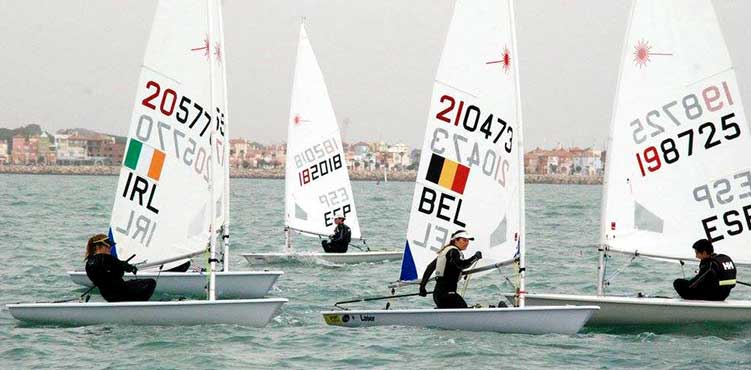 Howth's Aoife Hopkins (205770) chases Evi Van Acker of Belgium (210473) the 2012 Olympic Bronze Medalist, in Cadiz this week
Howth's Aoife Hopkins (205770) chases Evi Van Acker of Belgium (210473) the 2012 Olympic Bronze Medalist, in Cadiz this week
It has been weak on the water for the Radials but it has proved equally frustrating ashore for other Olympic classes where organisers cancelled racing in the 49er, 49er fx, 470 m / w and 420 due to lack of entries.
49er Winter Training Camp
Since last December, Ireland's five 49er teams have been treating Cadiz as a Winter training base and continue to train there til Wednesday. The ten sailors will get their first taste of international battle in Spanish waters early next month when they relocate to the the much–hyped Palma de Mallorca regatta.
'It never gets easier, you just get better' declare Dun Laoghaire's Donnelly brothers, Tadhg and Sean, having completed an intense Winter period perfecting boat handling manoeuvres in the high speed skiff. Their last session in Cadiz was an intense 11–day affair. They're heading home now to the National Yacht Club for a well–earned week off before traveling out to Mallorca for their first regatta of their 2020 campaign.
The crews are under the watchful eye of Tytus Konarzewsk who is one of Europe’s most respected 49er sailing coaches.
Next stop Palma de Mallorca will be an important Irish 49er marker because the Donnelly's will be up against Irish rivals Ryan Seaton and Seafra Guilfoyle, Matt McGovern and Robbie Gilmore, Mark Hassett and Oisin O’Driscoll as well as Robert Dickson and Sean Waddilove who will – hopefully – all be in action at the first mens skiff test towards Tokyo 2020.
But before Howth Yacht Club's Dickson and Waddilove hit the water again, they also face a race back to fitness after a calf injury sustained in Cadiz by crew Waddilove who found out just how tough Olympic sailing can be, 49er style.
The accident happened last Wednesday, the first day back training at the February Training Camp. Waddilove explains: 'It was quite windy that day, up to 25 knots at times and I think we must have decided to bear away at one of these times. We almost had the boat flat downwind, almost ready to run in and hoist when a gust hit and we were flung back upwind and capsized to leeward. First protocol when this happens is to jump clear of the boat or climb down onto the dagger board if you can. However the force was so strong Rob ended up going through the main sail and I went to jump off the wing to windward but the force made it hard to jump far enough away from the boat so I ended up hitting my leg off the dagger board on the way down'.
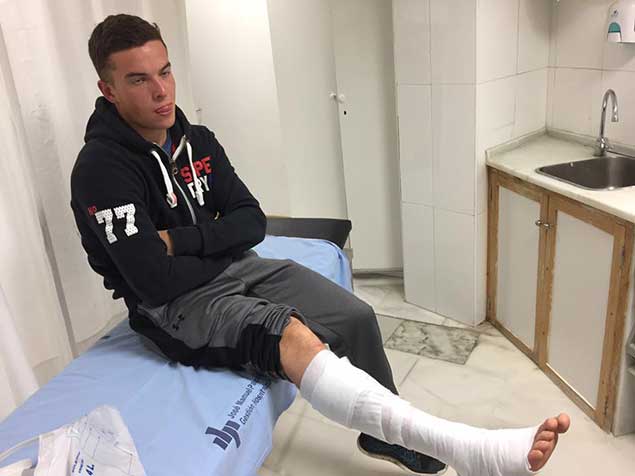 Sean Waddilove injury: 'My leg feels ok at the moment so I have been back training after a few light cycles, upper body gym sessions and a lot of icing, elevating and compression bandaging' Photo ISA/Facebook
Sean Waddilove injury: 'My leg feels ok at the moment so I have been back training after a few light cycles, upper body gym sessions and a lot of icing, elevating and compression bandaging' Photo ISA/Facebook
All the Irish 49er teams are claiming to have made 'really big improvements' over the past few months so there should be plenty of Irish mens skiff competition to come in March and the rest of the 2017 season.
Meanwhile, in the mens and womens Laser radial fleet, some well known names are finding the going tough in fickle Spanish breezes including 2012 Olympic bronze medalist Evi Van Acker of Belgium who is 17th on the mixed gender 114–boat scoresheet. (Downloadable results below). Ireland best results to date are Royal Cork's Johnny Durcan in 48th and Lough Derg's Aisling Keller 63rd.
Although December's youth sailing world championships did not deliver the result Johnny Durcan had hoped for, the young Crosshaven Laser Radial helmsman went on to race at the Australian National Championships in Adelaide last week. The Royal Cork and National Yacht Club sailor was competitive again and finished 19th overall despite two Yellow flags and a UFD which he says, 'really cost'.
Making the most of his trip down under, Durcan competes tomorrow at his third Australian event, the Radial youth national championships at the same venue, before returning home to studies in Ireland. It's an event, he says, where he aims to 'keep the scorecard clean'.
Annalise Murphy Absent For Rio Radial Replay at Sailing World Cup Final, Melbourne
Ireland's Annalise Murphy, who is flying her Moth dinghy at high speed in Bermuda, is not contesting this week's Sailing World Cup final in Melbourne but apart from the Irish silver medalists absence competition in Australian waters looks as intense as Rio at the sharp end of the 19–boat Laser Radial fleet. Gold medallist Marit Bouwmeester (NED) is favoured to win. The Dutch champion controlled a lot of the field at the Rio 2016 Olympic Games with an astute, professional display and quickly turned her attention to Tokyo 2020 immediately after winning Rio gold, heading to Japan to start familiarising herself with the next Olympic waters.
Danish Rio bronze medallist Anne-Marie Rindom will face off against Bouwmeester again, this time hoping to upset the Dutch party. Joining the Rio medallists in the fleet is current Laser Radial Youth World Champion and Rio Olympian Maria Erdi of Hungary who will warm up for the Youth Sailing World Championships by competing at the World Cup Final.
Great Britain's two-time Olympian Alison Young was down to race in Melbourne but sustained an ankle injury in the lead up and withdrew.
After an epic ten race series, Ireland's Annalise Murphy goes into Monday's medal race with no guarantee of a medal but the confidence in knowing she has sailed the most consistent series of her career. Where many have fallen, including the London 2012 Gold medallist Lilja Xu of China who finished in 18th position, on–form Murphy has put in a most impressive performance against everything Rio and the world's toughest female fleet had to throw at her. Now she has the chance to win Ireland's first sailing medal in 36–years (Read more about 1980's Silver medal in Tallinn).
The top five positions going in to Monday's crucial medal race are:
| 1 | NED | Marit Bouwmeester | 47 | |
| 2 | DEN | Anne-Marie Rindom | 55 | |
| 3 | IRL | Annalise Murphy | 57 | |
| 4 | BEL | Evi Van Acker | 66 | |
| 5 | FIN | Tuula Tenkanen | 68.6 |
So what are the best and worst results for Annalise to medal?
Well, no matter what, a fifth place finish will earn her at least bronze and could even win the gold if the Dutch girl finishes in 10th place and the Danish girl is not better than 6th.
If Annalise finishes 6th or worse, then she cannot afford to be more than 4 places behind the Belgian sailor.
If she finishes 7th or worse and is within 5 places of the Belgian sailor, then she cannot be more than 5 places behind Finland.
With a first place she takes at least a silver medal, and, if the Dutch competitor is more than 5 places behind, that silver become gold.
Between 1st and 5th and ahead of the Dane guarantees at least a silver.
MEDAL RACE SCENARIOS FOR ANNALISE MURPHY (IRL)
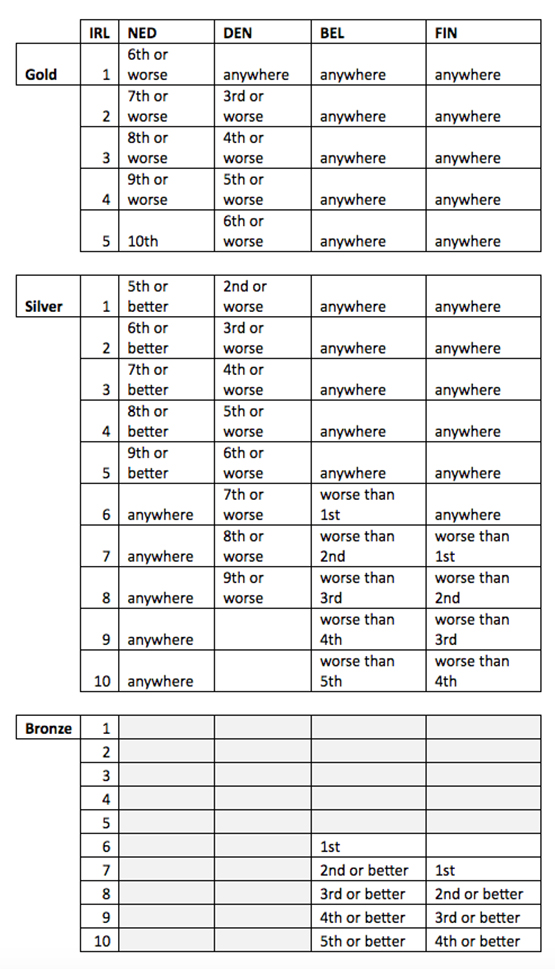
Annalise Murphy in Bronze Position, Prepares for Monday's Medal Race
In the final race of the Laser Radial qualification series, prior to Monday's medal race, Annalise Murphy finished seventh to complete the preliminaries in the bronze medal position. It is an excellent performance in difficult conditions by the National Yacht Club sailor with a string of very consistent results of 1, 13, 4, 7, 5, 2, (17), 12, 6, 7 in the 37–boat fleet.
But even with such a scoresheet a medal is not yet guaranteed. All Murphy's main rivals finished ahead of her in race ten and regatta leader Marit Bouwmeester (NED), who finished the race in second place, now has an 8 point gap over second placed Annemarie Rindom (DEN) going into the medal race.
Rindom's third place in this race, allowed her to leapfrog Murphy by two points, while another big gain was made by Belgium's Evi Van Acker who narrowed the gap to Murphy to 9 points.
Starting at the pin end of race ten, Murphy was third around the first weather mark and, like Bouwmeester favoured the right hand side of the run to round the bottom mark in fourth place. However, her chosen left side was not the place to be on the next upwind leg and, despite the full hiking conditions, she fell back in to the pack, rounding the 2nd weather mark in eighth place. Up ahead the Dutch girl maintained second behind Alison Young (GBR) thus widening the gap between herself and Murphy in overall points. The downwind saw the Irish girl lose a further four places, but a hike out to the right on the last upwind prompted a small recovery to 10th, consolidated on the final run, with a further three places gained by the finish line.
Read also: Annalise's Medal Race Possibilities
Bouwmeester has moved back to the top of the leaderboard and holds a useful eight-point buffer on second placed Rindom for the Medal Race. The London 2012 silver medallist is assured of another medal and is strongly positioned to win the gold that was so nearly hers four years ago.
The Laser Radials contested one race on the Pão de Açucar (Sugarloaf Mountain) course and one on Niterói, and Bouwmeester proved very adaptable to the different conditions, scoring 5,2. Murphy also sailed superbly to score a sixth and seventh which puts her just two points behind Rindom. However best performer of the day was Evi Van Acker (BEL) whose first and fifth has brought her back into medal contention after a shaky start to the regatta, compounded by the effects of an intestinal infection. She and fifth-placed Tuula Tenkanen (FIN) will have to sail a very good Medal Race to have a chance at silver or bronze, but it's possible.
For Bouwmeester the Olympic Medal Race is familiar territory, after taking silver in the tightest of contests four years ago in London. "I think this time the difference is I have a few points on second and I'm certain of a medal, but the similarity is I still have to do a good Medal Race on Monday. We like the Medal Race course, it's challenging, but I'm quite confident there even though you never quite know what's going to happen on that course."
Evi van Acker was looking forward to another period of rest before Monday's showdown. "I still need to rest, after today. I'm pretty tired. I had my best day so far, and I'm so happy with the way I recovered after the bad three days at the beginning. For me the 36 hours of treatment and rest in the middle of the week was very important to have more energy and keep fighting. I made sure I had a lot of rest, a lot of food and a lot of smiling."
The bronze medallist from 2012 will have to fight hard and sail well to be assured of another medal in Rio. "It feels like London all over again, pretty much the same people and same situation except this this time I'm a bit behind. So I'll have to sail well in the Medal Race. But I'll be ready to go."
Meanwhile, China’s Lijia Xu was disqualified from races seven and eight for ‘right of way’ incidents. The pre-event favourite had already discarded a disqualification earlier in the series meaning she had to count two maximum scores for Friday’s races. She ends the series in 18th overall and will not be in the medal race on Monday.
Annalise Murphy Aims For Monday's Medal Race Final With Last Qualifying Races Today
An extremely well–sailed qualifying series by Annalise Murphy will conclude this evening ahead of Monday's Medal Race climax.
The Laser Radials are scheduled for one race on the Pão de Açucar (Sugarloaf Mountain) course and one on Niterói, so it will take all–round skills to make the best of this critical day.
Today's courses will again have strong tides and high mountains disrupting the winds so it is a very strategic and tactical venue. Annalise has spent over 100 days on site learning the different courses that she can possibly race on. Her focus there has been on the strategically best way to sail the race track and the fastest technique to sail the boat given the sea states on the different race courses, so she is well prepared for the notoriously difficult venue.
Anne-Marie Rindom (DEN) hasn't revealed any weaknesses yet, the Dane putting in a very consistent series to hold a ten-point lead. But she is currently discarding a disqualification from race three so she can't afford any slip-ups. Marit Bouwmeester (NED) sits four points in front of Annalise with Tuula Tenkanen (FIN) not far behind.
Meanwhile, Finn Lynch concludes his first Olympics today in the mens Laser class and Ireland's two skiff teams Ryan Seaton and Matt McGovern and Andrea Brewster and Saskia Tidey in the 49erfx have their second day, both currently in fifth place overall.
Racing further out to sea in a westerly 9–12 knot breeze on Rio's Pia course, Annalise Murphy scored 12th in race eight and is in bronze medal position going into the final two qualifying races tomorrow. Race eight completed a tough day on the water for the Dubliner who lost the overall lead but stays very much in the mix for the medals, just 14–points off the lead.
Annalise rounded the top mark in race eight in ninth place in good company from the left and importantly had rivals Marit Bouwmeester (NED), Anne–Marie Rindom (DEN) and China's Lila Xu behind her.
On the first downwind leg, Annalise opted to go low, a good bit below the rhumb line and ended up getting pushed high to the leeward gate by overall leader Rindom.
![]() On the first downwind leg Annalise opted to go low, a good bit below the rhumb line
On the first downwind leg Annalise opted to go low, a good bit below the rhumb line
Nearly the entire 37–boat fleet headed left on the second beat, to the extent that it appeared to be consistently paying to be on the left side of the Pia course. Annalise was somewhere between tenth and 14th, and was furthest left on and on the layline, or above it, on the last quarter of the beat. The tracker put her 12th in a good lane when Boumeester tacked inside her and Annalise rounded 11th.
On the next run, Annalise went left and this time stuck more to the rhumb line, but it was neck and neck with the Dutch World Number One for the entire leg.
At the line, after 50 minutes of hard racing, Annalise took 12th with Bouwmeester 13th. Results are provisional and subject to protest.
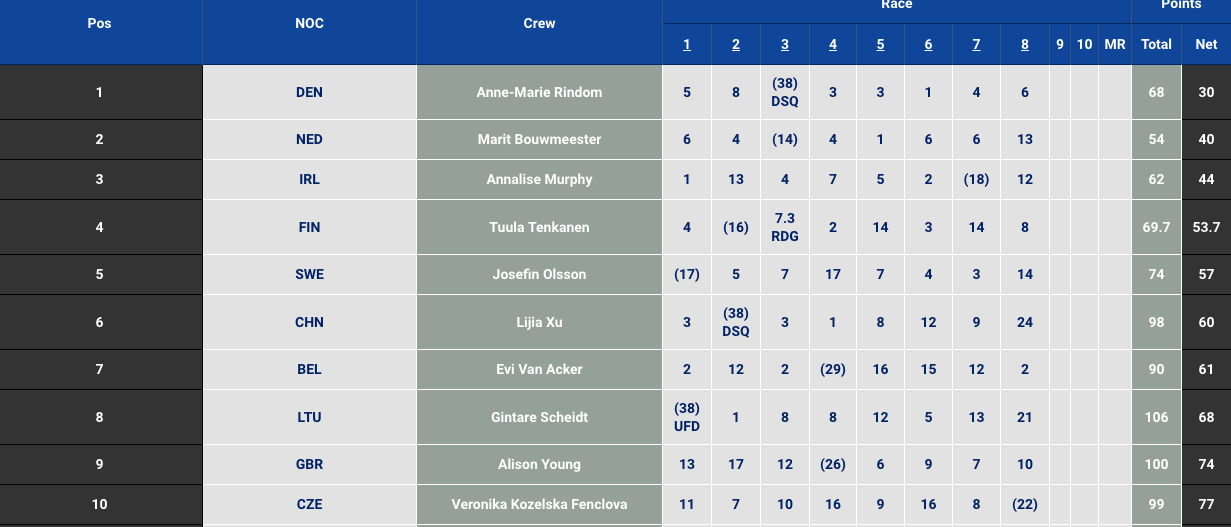 Top ten overall in the Radial class after eight races
Top ten overall in the Radial class after eight races
Races nine and ten will be held tomorrow.
Annalise Murphy has finished 18th in race seven and dropped to third in the overall standings. The race, her worst result of the regatta so far, was a struggle in eight to 12 knots but the Dubliner will be boosted by a great light air comeback over taking 10 boats on the second round of the Laser Radial course to get back into the teens in the 37–boat fleet. Race eight follows.
Overall top ten below after seven:
